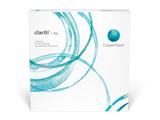
If you recently hit the big 4-0, you’re no stranger to the many age-related changes that affect your body as you get older. Of course, at this early stage, changes are rarely debilitating, but they are a gentle reminder that you’ll need to make some modifications in order to continue to enjoy the same activities that you did in your younger years.
Your eyes are no exception. In fact, near vision is often one of the first challenges you’ll face as you enter the fourth decade of life.
Beginning at around age 40, your eyes will likely begin to lose the ability to focus on objects up close. It’s called presbyopia, and it’s a natural part of the aging process in which the crystalline lens inside your eye becomes less flexible.
If you’re a contact lens wearer and over 40, and you have begun to notice that newspapers and menus look a little blurry, presbyopia is likely to blame. Fortunately, switching to different contact lenses is an easy fix that can probably spare you from the need to wear reading glasses.
Multifocal Contact Lenses
Originally, the only way to compensate for presbyopia with contact lenses alone was with a technique called monovision. People who wear monovision contact lenses are given a prescription for near vision in one eye and a lens for distance vision in the other.
Monovision is still in use today, but because your two eyes aren’t both corrected to have the optimal focus at all distances, it prevents your two eyes from working together. Thus, it may not be the optimal way to correct vision. A newer option is multifocal contact lenses, which contain multiple zones of vision correction instead of just one. This allows both your eyes to work together, allowing you to see things both up-close and at a distance.
Lenses to Fit Your Lifestyle
There used to be very few multifocal contact lens options, but today you’re no longer restricted by limitations like replacement schedule preference, material preference, or even conditions like astigmatism. CooperVision offers the following diverse range of options, designed to meet your individual vision requirements.
clariti® 1 day. clariti 1 day, including clariti 1 day multifocal, is a silicone hydrogel, daily disposable contact lenses. Silicone hydrogel is the healthiest soft contact lens material.* That’s because they allow more oxygen to pass through to your corneas than hydrogel lenses do. Silicone hydrogel creates a highly “breathable” lens that promotes whiter, brighter** eyes and helps keep your eyes healthy. Whether you’re nearsighted or farsighted, have astigmatism or presbyopia, clariti 1 day has you covered.
Biofinity® multifocal. This high-performance lens is also made of silicone hydrogel and features a lens design called Balanced Progressive™ Technology to help you see near and far objects, along with everything inbetween.
If you have presbyopia and want to try contacts, ask your eye doctor about which multifocal lens option is right for you.
* With higher oxygen permeability than hydrogel materials, silicone hydrogel contact lenses minimize or eliminate hypoxia-related signs and symptoms during lens wear.
Nothing in this blog post is to be construed as medical advice, nor is it intended to replace the recommendations of a medical professional. For specific questions, please see your eye care practitioner.





